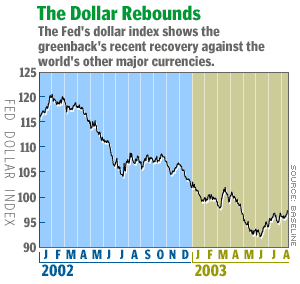NEW YORK (CNN/Money) -
The bloodied dollar has bounced back off the canvas in recent weeks, raising fears it could hurt U.S. manufacturing and corporate profits. But some analysts doubt the rebound has legs.
After falling for more than a year, the dollar's value against a basket of other world currencies has risen nearly 6 percent since mid-June, according to the Federal Reserve, as signs that economic growth is picking up have pushed interest rates on U.S. Treasury bonds higher.

In a front-page article in Wednesday's Wall Street Journal, some analysts fretted about how the dollar's gain could hurt the profits of U.S. exporters, since it makes their goods less competitive overseas.
But take heart, Procter & Gambles of the world -- the dollar's resurrection may be short-lived.
For one thing, the recent jump in long-term rates -- which may have attracted some overseas investors seeking greater returns -- could be unsustainable, since so much of it has been driven by technical factors, such as complex investments in mortgage securities.
"We've seen markets get ahead of themselves in bonds and in currencies as well," said Lara Rhame, a foreign exchange analyst at Brown Brothers Harriman. "There are signs that markets have now gotten too optimistic about not only the size of the U.S. recovery, but the speed; our medium-term forecast is still very much of euro strength and dollar weakness."
Rhame said Brown Brothers Harriman expects one euro to buy $1.25 by mid-2004, meaning the dollar will back off pretty significantly from current levels. The euro buys about $1.11 today.
Even if Rhame and some of the more pessimistic economists are wrong and U.S. rates move higher still, foreign interest rates will probably start rising as the U.S. economy -- the world's largest -- acts like a locomotive and pulls the rest of the world with it.
"The rise in the dollar is likely to be limited to maybe a maximum of 3 to 5 percent," said Ashraf Laidi, chief currency analyst at MG Financial Group, a New York-based foreign exchange firm, because higher interest rates overseas will continue to attract money, effectively keeping a lid on the dollar's gains.
Laidi, Rhame and other economists also noted there is something that will keep the dollar from getting too far ahead of itself: the huge deficit in the nation's current account, the broadest measure of trade.
The current account, which measures the flow of goods, services and cash into and out of the economy, jumped to $136.1 billion in the first quarter, according to the Commerce Department. Spread out over the entire year, that would amount to more than 5 percent of the nation's economy.
Throw in a federal budget deficit expected to be about $400 billion, or nearly 4 percent of GDP, and you have a massive "twin deficit" unlike anything since the 1980s. And these deficits are funded by a steady inflow of billions of dollars a day of foreign capital into U.S. markets.
A few economists, including Morgan Stanley chief economist Stephen Roach, don't believe this situation can last forever, predicting that the United States will eventually be abandoned by its overseas sugar daddies, resulting in a plunge in the dollar as demand for greenback-denominated assets falls.
"There is good reason to believe that a sharp weakening in the value of the U.S. currency is essential to the global rebalancing that must begin to take place if the world's current account imbalances are to be corrected," Roach said in a recent research note.
But few economists expect such a dramatic, sudden fall in the dollar, which could seriously damage not only the United States but other major economies around the world -- a slow, shallow decline seems more likely.
For one thing, the United States has run enormous current account deficits -- and even enormous "twin deficits" -- before, with the dollar nevertheless staying remarkably strong.
In the 1980s, for example, twin deficits didn't kill the dollar because high interest rates lured overseas buyers to U.S. Treasury bonds. In the late 1990s, the trade deficit was high, but overseas capital poured into U.S. markets to buy into the tech-bubble boom.
On the other hand, trade and budget deficits may be more dangerous this time, according to Northern Trust senior economist Paul Kasriel, because he believes too much of the current flow of cash into the U.S. is being spent on cars, cruise missiles and other stuff that does little to improve the economy's future productivity.
"It's not so much the size of the deficit, but what we're doing with the funds," Kasriel said.

|

